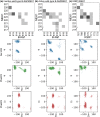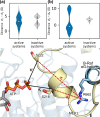The mechanism of activation of MEK1 by B-Raf and KSR1
- PMID: 35508574
- PMCID: PMC9068654
- DOI: 10.1007/s00018-022-04296-0
The mechanism of activation of MEK1 by B-Raf and KSR1
Abstract
MEK1 interactions with B-Raf and KSR1 are key steps in Ras/Raf/MEK/ERK signaling. Despite this, vital mechanistic details of how these execute signal transduction are still enigmatic. Among these is why, despite B-Raf and KSR1 kinase domains similarity, the B-Raf/MEK1 and KSR1/MEK1 complexes have distinct contributions to MEK1 activation, and broadly, what is KSR1's role. Our molecular dynamics simulations clarify these still unresolved ambiguities. Our results reveal that the proline-rich (P-rich) loop of MEK1 plays a decisive role in MEK1 activation loop (A-loop) phosphorylation. In the inactive B-Raf/MEK1 heterodimer, the collapsed A-loop of B-Raf interacts with the P-rich loop and A-loop of MEK1, minimizing MEK1 A-loop fluctuation and preventing it from phosphorylation. In the active B-Raf/MEK1 heterodimer, the P-rich loop moves in concert with the A-loop of B-Raf as it extends. This reduces the number of residues interacting with MEK1 A-loop, allowing increased A-loop fluctuation, and bringing Ser222 closer to ATP for phosphorylation. B-Raf αG-helix Arg662 promotes MEK1 activation by orienting Ser218 towards ATP. In KSR1/MEK1, the KSR1 αG-helix has Ala826 in place of B-Raf Arg662. This difference results in much fewer interactions between KSR1 αG-helix and MEK1 A-loop, thus a more flexible A-loop. We postulate that if KSR1 were to adopt an active configuration with an extended A-loop as seen in other protein kinases, then the MEK1 P-rich loop would extend in a similar manner, as seen in the active B-Raf/MEK1 heterodimer. This would result in highly flexible MEK1 A-loop, and KSR1 functioning as an active, B-Raf-like, kinase.
Keywords: Assemblies; Autoinhibition; Cancer; ERK; KSR; MAPK; MD simulations.
© 2022. The Author(s).
Conflict of interest statement
The authors have no relevant financial or non-financial interests to disclose.
Figures










Similar articles
-
A Raf-induced allosteric transition of KSR stimulates phosphorylation of MEK.Nature. 2011 Apr 21;472(7343):366-9. doi: 10.1038/nature09860. Epub 2011 Mar 27. Nature. 2011. PMID: 21441910
-
The kinase activity of kinase suppressor of Ras1 (KSR1) is independent of bound MEK.J Biol Chem. 2004 Jun 18;279(25):26210-4. doi: 10.1074/jbc.M401323200. Epub 2004 Apr 13. J Biol Chem. 2004. Retraction in: J Biol Chem. 2013 Nov 22;288(47):34052. doi: 10.1074/jbc.A113.401323. PMID: 15084597 Retracted.
-
Signaling dynamics of the KSR1 scaffold complex.Proc Natl Acad Sci U S A. 2009 Jul 7;106(27):11022-7. doi: 10.1073/pnas.0901590106. Epub 2009 Jun 18. Proc Natl Acad Sci U S A. 2009. PMID: 19541618 Free PMC article.
-
Signaling threshold regulation by the Ras effector IMP.J Biol Chem. 2009 Apr 24;284(17):11007-11. doi: 10.1074/jbc.R800082200. Epub 2008 Dec 17. J Biol Chem. 2009. PMID: 19091743 Free PMC article. Review.
-
Inflammatory bowel disease reveals the kinase activity of KSR1.J Clin Invest. 2004 Nov;114(9):1233-7. doi: 10.1172/JCI23441. J Clin Invest. 2004. PMID: 15520853 Free PMC article. Review.
Cited by
-
Drug resistance and tumor heterogeneity: cells and ensembles.Biophys Rev. 2025 May 31;17(3):759-779. doi: 10.1007/s12551-025-01320-y. eCollection 2025 Jun. Biophys Rev. 2025. PMID: 40727661 Free PMC article. Review.
-
Genome-wide association study and subsequent functional analysis reveal regulatory mechanism underlying piglet diarrhea.Anim Biosci. 2025 Apr;38(4):612-628. doi: 10.5713/ab.24.0547. Epub 2024 Oct 28. Anim Biosci. 2025. PMID: 39482997 Free PMC article.
-
Pioneer in Molecular Biology: Conformational Ensembles in Molecular Recognition, Allostery, and Cell Function.J Mol Biol. 2025 Jun 1;437(11):169044. doi: 10.1016/j.jmb.2025.169044. Epub 2025 Feb 25. J Mol Biol. 2025. PMID: 40015370 Review.
-
Mechanism of Abnormal Activation of MEK1 Induced by Dehydroalanine Modification.Int J Mol Sci. 2024 Jul 8;25(13):7482. doi: 10.3390/ijms25137482. Int J Mol Sci. 2024. PMID: 39000589 Free PMC article.
-
Targeted therapy of papillary craniopharyngioma.Med Oncol. 2025 Jul 22;42(8):367. doi: 10.1007/s12032-025-02920-0. Med Oncol. 2025. PMID: 40696244 Free PMC article. Review.
References
MeSH terms
Substances
Grants and funding
LinkOut - more resources
Full Text Sources
Research Materials
Miscellaneous

